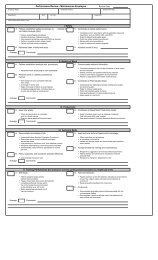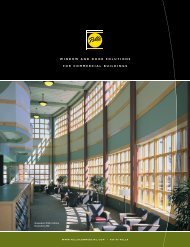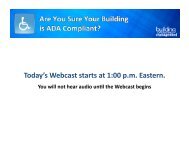Building Operating Management September 2011 - FacilitiesNet
Building Operating Management September 2011 - FacilitiesNet
Building Operating Management September 2011 - FacilitiesNet
Create successful ePaper yourself
Turn your PDF publications into a flip-book with our unique Google optimized e-Paper software.
86<br />
buildingoperatingmanagement<br />
SEPTEMBER <strong>2011</strong><br />
Most airside economizer damper systems are intended<br />
to operate in a manner similar to this:<br />
When outside air conditions are<br />
very cold: The unit is in the heating<br />
mode. Mechanical cooling is off,<br />
economizer dampers are at minimum outside<br />
air position, and the heating coil operates to<br />
maintain supply air temperature setpoint.<br />
When outside air conditions are cold: The<br />
unit is in economizer cooling mode. The<br />
heating coil is off, mechanical cooling is<br />
off, and economizer dampers modulate to<br />
maintain supply air temperature setpoint.<br />
When outside air conditions are cool:<br />
The unit is in “integrated economizer” and<br />
mechanical cooling mode. Heating coil<br />
is off, economizer dampers are at 100<br />
percent outside air position, and mechanical<br />
cooling operates to maintain supply air<br />
temperature reset.<br />
When outside air conditions are hot: The<br />
unit is in mechanical cooling mode. The<br />
heating coil is off, economizer dampers<br />
are at minimum outside air position, and<br />
mechanical cooling operates to maintain<br />
supply air temperature setpoint.<br />
This general description applies to most<br />
systems. The specifi c type of system,<br />
climate and control sequence will dictate<br />
how a system is intended to perform for<br />
actual installations.<br />
— Dave Moser<br />
ed and maintain the overall performance of the system.<br />
This is good to do for other HVAC sensors too, especially<br />
those used as inputs to control sequences, such as measuring<br />
chilled water flow for a chiller staging sequence.<br />
FOR MORE INFORMATION<br />
>>> on airside economizer fundamentals, methods<br />
of control, and test procedures, consult the Functional<br />
Testing and Design Guides at www.peci.org/ftguide<br />
Always consider the effects on other systems and include<br />
necessary precautions in any test procedures.<br />
Tackling Controls Issues<br />
Airside economizer damper control requires close coordination<br />
and integration with the system’s heating and<br />
cooling systems to maximize the energy efficiency of the<br />
system. Common controls-related issues, and their corresponding<br />
fixes, include:<br />
• The economizer is not integrated with mechanical cooling.<br />
It’s beneficial to operate the system in full economizer<br />
mode (100 percent outside air) when the outside air conditions<br />
are just a bit cooler than inside conditions and the system<br />
is asking for mechanical cooling. This helps reduce the<br />
mechanical cooling load by keeping the cooling coil’s inlet<br />
air (mixed air) temperature as low as possible. Take a look at<br />
your air handler control sequences, and observe system operation<br />
during these cool outside air conditions (e.g., 55 F to<br />
65 F outside air, depending on the control sequence) to verify<br />
you’re getting the full benefit of airside economizer operation.<br />
• Economizer control disabled. Some buildings have<br />
disabled their airside economizers in reaction to a performance<br />
issue where the economizers weren’t the main<br />
culprit or due to a lack of understanding of the system’s<br />
benefits and performance. If you’ve disabled your airside<br />
economizers, consider re-enabling them, but also address<br />
any outstanding performance issues.<br />
• Reduced economizer effectiveness. Past existing<br />
building commissioning projects have uncovered many<br />
control strategies that reduce the efficiency of the system.<br />
Two examples: a 30 percent minimum return air damper<br />
setpoint rather than a zero percent setpoint, and a low<br />
economizer changeover setpoint (the point at which the<br />
system changes from economizer mode to non-economizer<br />
mode, usually around 70 F outside air temperature).<br />
Review your control sequences to see if there are any opportunities<br />
for increased energy efficiency.<br />
In general, first determine the intended operation of the<br />
airside economizer system. Review the original construction<br />
documents and consult with your operating staff to see how<br />
the system is currently programmed to operate. Investigate<br />
and implement optimization opportunities based on this exercise.<br />
Then, periodically test the system to determine if it’s<br />
performing as intended and take corrective action when it’s<br />
not. When testing the control sequences, be sure to test them<br />
in all operating modes (heating, economizer cooling, integrated<br />
economizer and mechanical cooling, and mechanical<br />
cooling with minimum outside air).<br />
As a final note, your building automation system (BAS)<br />
can be a powerful tool to help monitor the performance of<br />
the economizer system. Periodically collecting and analyzing<br />
BAS trend data can be a good way of viewing system<br />
performance. X-Y scatter plots are often more telling than<br />
time-series plots, which can be confusing. Neither will<br />
show what problem exists, only that there is a problem requiring<br />
investigation. Be sure to filter the data to show “fan<br />
on” operation only, and also be sure that your BAS temperature<br />
and enthalpy sensors are calibrated.<br />
Airside economizers can save a significant amount of<br />
energy, but they need to be maintained for their “free cooling”<br />
energy benefits to be realized. ■<br />
Dave Moser, P.E., is a senior engineer at PECI. He provides<br />
engineering services for a diverse range of projects and<br />
programs at PECI, all centered on building energy efficiency.<br />
His experience includes implementing and managing the<br />
technical aspects of utility existing building commissioning<br />
programs, leading in-building existing building commissioning<br />
projects, and supporting research projects. You can<br />
reach him at dmoser@peci.org.<br />
Email questions to edward.sullivan@tradepress.com.





